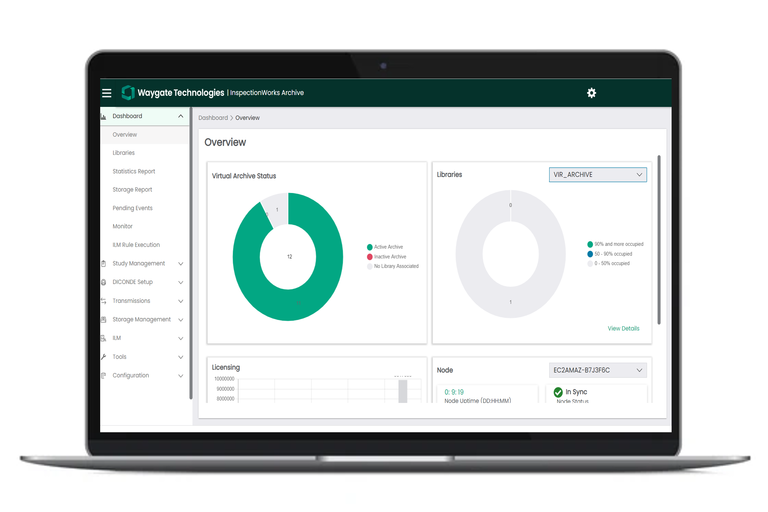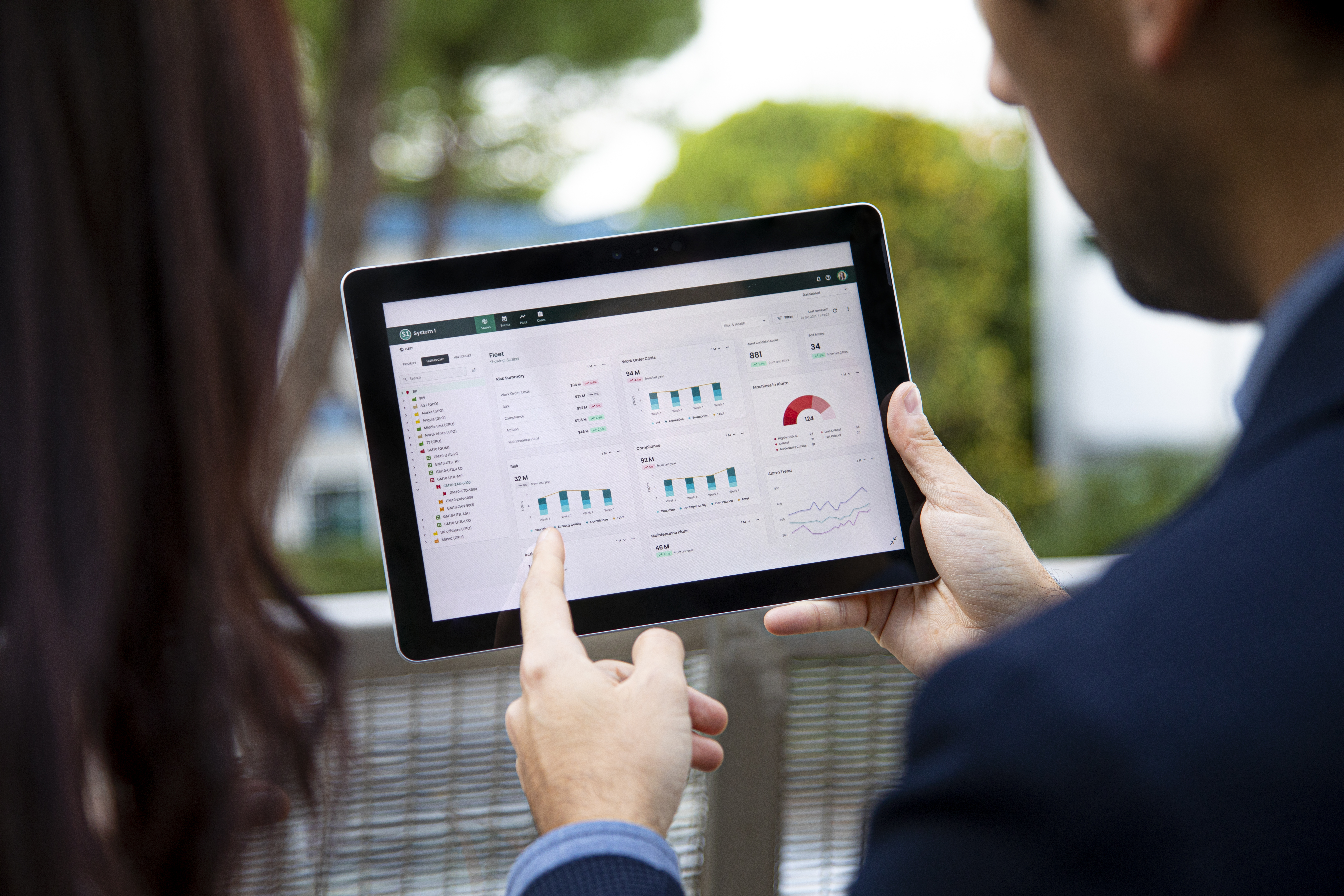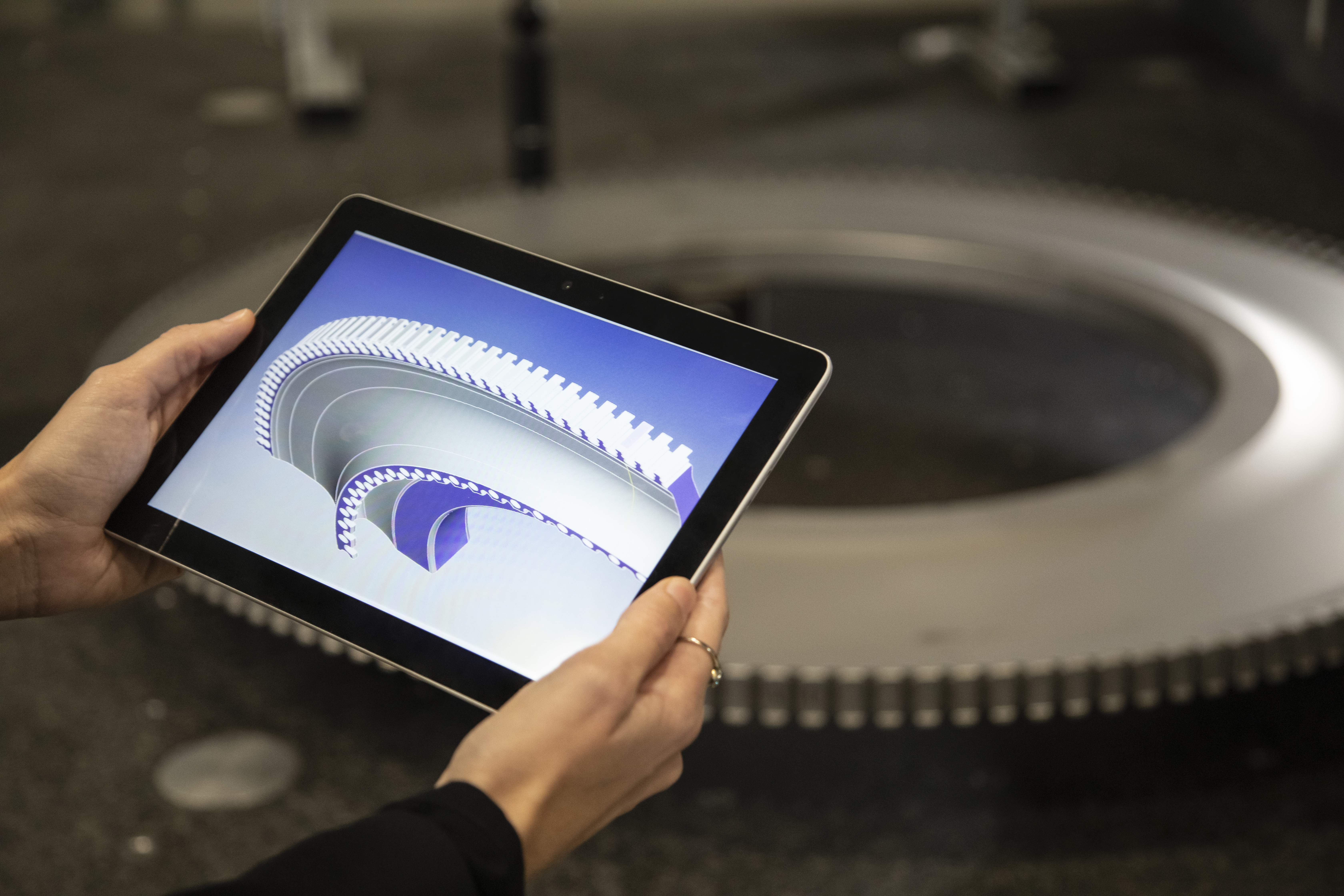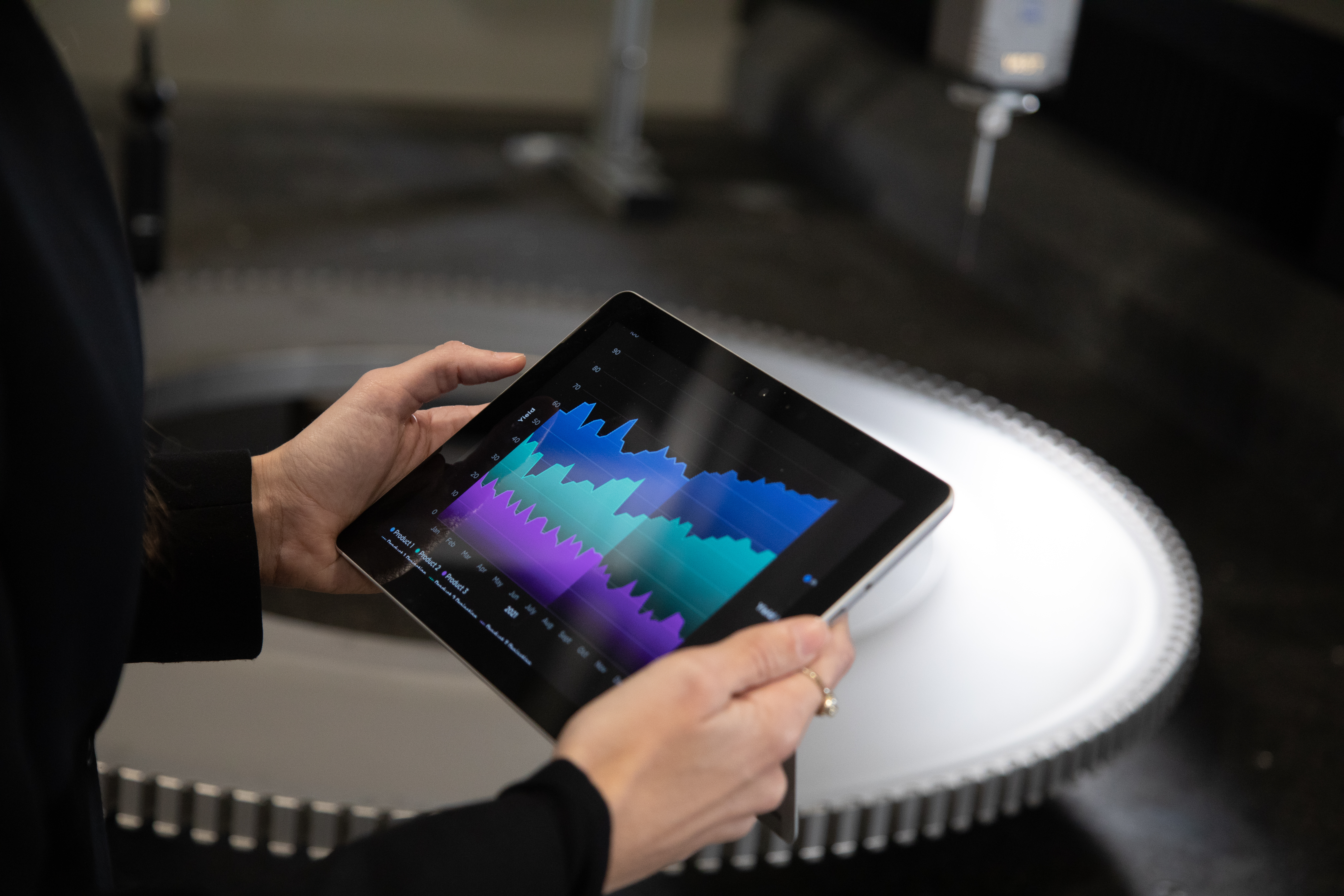
InspectionWorks Archive
InspectionWorks Archive (IWA) is an extremely efficient data management and storage solution, which allows easy access to large volumes of inspection information. Hundreds of millions of images can be stored at a central location, in the industry standard DICONDE-compliant format.
It accepts images from remote workstations and stores these using various compression techniques to save storage space without sacrificing image quality. Input and retrieval of information is quick and easy, as a simple DICONDE tagging system eliminates the need for the complex image file naming conventions often associated with high volume information storage.
InspectionWorks Archive delivers a secure, flexible and vendor neutral DICONDE / ASTM compliant software storage solution for non-destructive testing images and information. Our Archive software offers high volume data storage for Oil & Gas or Aerospace industry, deployed on enterprise hardware and server image to readily tie into user's enterprise networks and security frameworks for highly efficient company wide DICONDE data generation, review and storage.
- Store and manage DICONDE compliant images.
- Capability to be the main engine for image exchange.
- Auto-routing, pre-fetching
- Image Lifecycle Management – move, compress and delete image over time based on configurable rules
"IW Archive is the only sustainable and scalable data management and storage solution that can handle large NDT data sets, that is truly DICONDE compliant, able to synchronize with cloud and provide effective hands-off storage, recall and search functionality."
Aviation User, NDE Process Engineer, Level III,
Highlights
Benefits
SMART.Reliable.Unified data storage and data management
- Improved competency in how data retention works: less downtime, lower risk of data loss, and a better user experience.
- Streamline operations with unified, rule-based secure storage for any DICONDE acquisition and analysis software.
- Save time by applying metadata to ease search, categorization, supervision and discovery.
- Be confident with compatible redundant and disasterproof hardware and software.
Features
The DICONDE compliant solution to storing high volumes of vendor neutral NDT inspection data on a global company IT network.
- A totally DICONDE-based vendor-neutral archival solution: ensures that multi-modal inspection data will never become obsolete or inaccessible.
- Simplified information sharing: data can now be readily accessed from a single storage source by any number of remote interrogation sites.
- Interfaces with a wide range of hardware and software long-term data storage solutions: meet present and future needs.
- Provides foundation for data mining: compare inspections carried out at different times using different inspection modalities.
- Robust and secure: disaster recovery plans are incorporated, and built-in redundancy can be included to ensure constant data availability.
Applications
InspectionWorks Archive drives inspection productivity in various industries
- In aerospace, all inspection data can be stored for upwards of 50 years and still be quickly retrieved when required.
- In oil & gas, weld inspection data can be transmitted to the Rhythm Archive, where it is accessible to expert resources for review and analysis.
- In power generation, in-service assets can be better managed to help improve their operating life and reliability.
- In transportation, inspection planning can be faster, more meaningful, and targeted, by referring to the last inspection period.
InspectionWorks Archive is a totally DICONDE-based archival solution. DICONDE (Digital Imaging and Communication in Non-Destructive Evaluation) is an extension of the DICOM standard which was developed for the medical sector by vendor companies and user groups. DICONDE is now used by virtually every medical profession that utilizes images.
By using the vendor neutral InspectionWorks Archive, users can enjoy a range of benefits. They can avoid legacy data issues and will not have to maintain old systems or convert old data in the future. They will also be able to use inspection data from various DICONDE-compliant equipment manufacturers, including NDT workstations, as DICONDE is non-proprietary. In addition, it will be possible to review historical inspection data with future software tools.
Flexibility and scalability are further advantages of InspectionWorks Archive, as the system can be integrated with a number of long-term storage solutions, such as Network Attached Storage (NAS) systems, Amazon S3, or Microsoft Azure Blob Container Storage. Alternatively, you can choose the new option to deploy the InspectionWorks Archive software directly onto your own enterprise server with your chosen data storage solution.

InspectionWorks Archive offers a significant step-change in information sharing over the existing NDT software infrastructure. Often, data is archived on analysis laptops by storing on the hardware’s limited hard disc capacity or on near-line DVD/CD.
Consequently, locating data for an inspection in a multiple workstation configuration can be rather complicated and time-consuming. With InspectionWorks Archive information from all the acquisition and analysis software is available at one central repository so that data searching is more efficient. The platform can control image information workflow so that data can be routed to other Review workstations to allow further analysis and then back to InspectionWorks Archive again.
Virtual archiving is yet another feature of InspectionWorks Archive. This allows information managers to automatically segregate data, on a customer basis, on a department basis or on any storage specific basis, to provide customized, secure archives within the InspectionWorks Archive. Companies require global DICONDE data management solutions like InspectionWorks Archive that can be integrated into their own infrastructure/enterprise network.

By improving data sharing and providing a central, safe, long term information repository, InspectionWorks Archive can significantly affect profitability, with immediate benefits in time saving and reliability. However, InspectionWorks Archive can also bring important productivity improvements of as much as 50%, as pre-inspection plans can now be formulated more efficiently by taking actual inspection history into account. A similar order of productivity improvement can also be achieved in post-inspection, as only relevant inspection data needs to be sent for further analysis.

Waygate Technologies has a collection of software that provide efficient and effective solutions for the acquisition, analysis, and archival of multi-modal digital inspection data. The software is typically made up of three integrated modules depending on modality. These modules are:
Acquisition software: This software interacts with the relevant inspection source to collect the digital inspection information. Current software supported modalities include CR, DR, film digitizers, 2D CT, 3D CT, and other technologies. It handles calibration, acquisition, and basic analysis and reporting.
Analysis software: accepts data from acquisition or other systems either by file or network forwarding using DICONDE or other protocols. The analysis has the capability to enhance and manipulate digital data and features application tools for analysis, measurement and further enhancement of images. The software allows information to be stored and shared on-line using its disc capacity, CD/DVD, USB flash drive or network storage. It also seamlessly integrates with archival systems.
InspectionWorks Archive: expands the operating potential of Waygate Technologies’ and other parties’ acquisition and analysis software enormously. Now, all information can be made globally available to every NDT user within a network.

Rules-based archiving enables the user of InspectionWorks Archive to establish a series of rules that, when put in place, makes data management and storage effortless. This is achieved by:
- Automatically storing and/or distributing images according to the part type. Different rules can apply subject to SKU or bar code of the part
- In auto-routing, incoming images are checked against routing rules that are defined for a specific archive and subsequentially stored in the correct library destination.
- Library Match Rules
- If you have more than one library installed, different libraries can be used for different images. For example, UT images can be stored in one library and X-ray images in another. Library match rules can be as simple or complex as needed, providing very fine control over how your libraries are utilized.
- Image Lifecycle Management (ILM)
- ILM enables the storage, compression and deletion of DICONDE images. Aa a rules engine the ILM enables the move, compress or delete feature which can be used according to the rules, policies and legal requirements of the organization. Audit mechanisms track which images/documents have been moved/deleted and when.
- Move Rule: moves DICONDE files from one library to the another within an archive.
- Compression Rule: compresses DICONDE files series, setting of compression type and setting of percentage of compression
- Deletion Rule: deletes DICONDE files according with legal timeliness and document retention policies and min. 10 days on pending before deletion is executed as safety measure.

Yes. The InspectionWork Archive can store the images in the local cache of th Server itself or on a storage appliance such as EMC SAN, NAS, or Centera devices. You are able to attach to a CIFS share on any NAS type storage appliance within the InspectionWork Archive.
The following types of storage are used with InspectionWork Archive:
Amazon AWS S3 and Microsoft Azure Blob Storage
The data can be separated in two different ways. First is storage level only, by building more than one 'Library' within the EA Application it is possible to create separation. Second is Archive level, by using Virtual Archives to segregate customer data. Please request pricing on additional Virtual Archives for your InspectionWork Archive from your Sales representative.
The DICONDE files are stored as received from the modality. The header of each file is parsed upon receipt and selected elements from the DICONDE header are stored within the database as well. This provides speed in locating the appropriate file(s) for import. This tag selection is made by your Archive administrator during installation of the InspectionWork Archive.
Yes. InspectionWork Archive server follows the DICONDE protocol. The metadata is stored within the SOL database on drive D, and only contains a pointer to the images within the storage Library.
The Archive Server has a local MS SQL Server Database.
The Review Workstation has a local MS Access database
The RT workstation also has an MS Access database.
You can either send your acquired data to a Review workstation or directly to the Archive. If images are first sent to a Review workstation, you would forward to the Archive from there, else the Review workstation would import an image from the Archive. At the time the data is being analyzed by Review it is local in the MS Access database.
Yes, you are able to have your Archive located anywhere on your network. Your network speed/bandwidth will be your determining factor as to how favorable this setup will be for your InspectionWork Archive system.
Yes, you can setup a central Archive in one location and then have other locations with Archives local to them. Though our Shadowing feature you can then have the studies routed from the local Archives to the central Archive. This feature is dependent on the Storage Commitment component of the DICONDE standard being fully supported by the remote Archive (Note: auto forwarding of images does not verify if all the images transfer where shadowing does, so it is important to use shadowing vs. auto forwarding function.)
The SQL Databases are backed up to a customer provided CIFS Share via SOL backup scripting. To eliminate the single point of failure inherent with a single DB/application server and storage Library setup, we recommend a second EA server and Storage Library. Our Shadowing feature will queue for transmission to the secondary server all images archived on the primary server, and ensure that they are received on the second server by tracking DICONDE Storage Commitments at the image level. If even one image in a study fails to return Storage Commitment the entire study is requeued for transmission. Alternatively, it would be up to your IT group to manage your InspectionWork Archive server and the data as it manages other servers/data in your business, i.e. follow your current IT protocol. (e.g. Backup SQL Server database and images.)
Database backups are executed using the standard MS SQL Backup utility. These are typically written to a CIFS Share provided by the customer. However, we do also support backups to a customer enterprise backup server if desired. Loading of the client on our server is allowed, no SQL Server specific client is needed. We will write our scripted backup to a local drive, and the enterprise client can capture the contents of this one folder nightly.
The single InspectionWork Archive Server and storage device provides only RAID level protection for the long term image storage devices. To best protect the long term storage we offer a shadow server option. The shadow server is a second Archive server and storage device. With the shadow server installed in a remote location from the primary Archive server, the risk of a single event causing loss of availability of the Archive server is greatly reduced. Alternatively tape backup solutions or storage level replication are options that could be employed to provide additional storage level protection, but are still downtime vulnerable in the event of a hardware failure within the Archive.
- Select hardware that meets the server requirements.
- Collect all software and licenses you need during installation.
- Review the direct-attached storage requirements and decide on an appropriate logical disk layout.
Waygate Technologies service contracts are available and Waygate technologies support is then available for all issues. Our Tech Support and Services teams will Remote Access into your system for help with installation, help with upgrades or other L service related issues.



